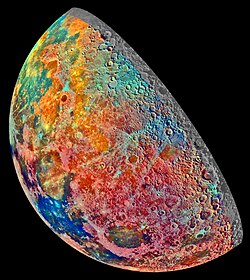False color
False color (or false colour) refers to a group of color methods used to display recorded images in color. A false-color image is an image which shows an object in colors different from that which a true-colour photograph would show.
In addition, there is false color used for visualization of genuine data.
A photograph shot in color will show the colors in the picture as they appeared on the film, or to the sensor of a digital camera. Since most films and most digital cameras are made to show the world as human color vision would see it, this is known as true-color image. In a false color image, the color shown in the image does not correspond to the one the human eye would see. In such an image, color is used for extra information that the eye would not see. Many false color images, for example, show infrared light that humans cannot see. +{{{1}}}−{{{2}}}
False Color Media
An image of Tasmania and surrounding waters using density slicing to show phytoplankton concentration. The ocean color as captured by the satellite image is mapped to seven colors: Yellow, orange and red indicate more phytoplankton, while light green, dark green, light blue and dark blue indicate less phytoplankton; land and clouds are depicted in different colors.
The 2004 United States presidential election, visualized using a choropleth map. Support for the Republican and Democratic candidates are shown in shades of the parties' respective red and blue traditional colors.
References
- ↑ "The Landsat 7 Compositor". landsat.gsfc.nasa.gov. 2011-03-21. Archived from the original on 2013-09-21. Retrieved 2012-09-01.








